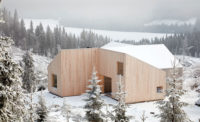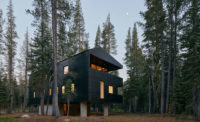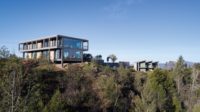Design Vanguard 2015
Mork-Ulnes Architects, San Francisco/Oslo
A bicultural practice produces a growing body of work distinguished by quirky minimalism.

Mork Ulnes Architects
Photo © Bruce Damonte

Hanbury Street
For a 2014 competition that stipulated the redevelopment of an existing commercial stable in London’s hip Shoreditch district, Mork-Ulnes inserted a two-story mirrored cube within the glaze-roofed courtyard. This satisfied the client’s need for additional office space, while maintaining the historic nature of the building’s facade. Suspended from four pedestrian bridges, the hovering cube features a roof garden and effectively dematerializes, reflecting the textured brick walls around it.
Photo © Bruce Damonte

Moose Road House
Two couples who purchased property in the Northern California town of Hopland asked Mork-Ulnes for a retreat that would take advantage of the site’s three main views and would also leave the trees on the site intact. The home branches around the native oaks, using a steel-pier foundation to avoid damaging tree roots; its three prongs point squarely at the views. Built for $170 a square foot, it has a simple floor plan that wastes no space on corridors, using bathroom volumes to delineate the two bedrooms. To keep costs down, the design team used bonderized sheet metal as cladding, unfinished plywood on the walls, and oriented strand board floors bleached with a traditional Scandinavian lye solution.
Photo © Bruce Damonte

Moose Road House
Photo © Bruce Damonte

Meier Road Barn + Amoeba
Mork-Ulnes (with SFOSL) replaced a dilapidated barn on a three-acre family compound in Sonoma County with a contemporary version to house an art studio, a small office, and workshop. To maximize height and daylight, he inverted the classic gable into a butterfly roof. The building still cleaves to the agricultural vernacular with the extensive use of reclaimed barn siding. An adjacent concrete dining pavilion, dubbed the Amoeba, opens to a garden. (The architect is currently working on a design for a new guesthouse on the property, which has a 1930s bungalow as its primary residence.)
Photo © Bruce Damonte

Moose Road House (2011)
Hopland, California
Two couples who purchased property in the Northern California town of Hopland asked Mork-Ulnes for a retreat that would take advantage of the site’s three main views and would also leave the trees on the site intact. The home branches around the native oaks, using a steel-pier foundation to avoid damaging tree roots; its three prongs point squarely at the views. Built for $170 a square foot, it has a simple floor plan that wastes no space on corridors, using bathroom volumes to delineate the two bedrooms. To keep costs down, the design team used bonder- ized sheet metal as cladding, unfinished plywood on the walls, and oriented strand board floors bleached with a traditional Scandinavian lye solution.
Photo © Bruce Damonte

Meier Road House (2012)
Sonoma County
Mork-Ulnes (with SFOSL) replaced a dilapidated barn on a three-acre family compound in Sonoma County with a contemporary version to house an art studio, a small office, and workshop. To maximize height and daylight, he inverted the classic gable into a butterfly roof. The building still cleaves to the agricultural vernacular with the extensive use of reclaimed barn siding. An adjacent concrete dining pavilion, dubbed the Amoeba, opens to a garden. (The architect is currently working on a design for a new guest- house on the property, which has a 1930s bungalow as its primary residence.)
Photo © Bruce Damonte

Akersveien Residence (2014)
Oslo
At one time the billiards-room of a mansion, this duplex apartment now functions as a residence for a young family. Originally built in 1899 and converted to apartments in the 1930’s, this renovation transforms the space to align with the needs of the client’s contemporary lifestyle. Existing walls were demolished and reconfigured to create a generous open kitchen and living area, while skylights and windows placed in the upper level partition walls allow light to filter through the rooms uninterrupted. To counter the harsh Scandinavian winters, the interior is painted white to maximize daylight.
Photo © Bruce Damonte

Akersveien Residence (2014)
Oslo
At one time the billiards-room of a mansion, this duplex apartment now functions as a residence for a young family. Originally built in 1899 and converted to apartments in the 1930’s, this renovation transforms the space to align with the needs of the client’s contemporary lifestyle. Existing walls were demolished and reconfigured to create a generous open kitchen and living area, while skylights and windows placed in the upper level partition walls allow light to filter through the rooms uninterrupted. To counter the harsh Scandinavian winters, the interior is painted white to maximize daylight.
Photo © Bruce Damonte

Akersveien Residence (2014)
Oslo
At one time the billiards-room of a mansion, this duplex apartment now functions as a residence for a young family. Originally built in 1899 and converted to apartments in the 1930’s, this renovation transforms the space to align with the needs of the client’s contemporary lifestyle. Existing walls were demolished and reconfigured to create a generous open kitchen and living area, while skylights and windows placed in the upper level partition walls allow light to filter through the rooms uninterrupted. To counter the harsh Scandinavian winters, the interior is painted white to maximize daylight.
Photo © Bruce Damonte

Hanbury Street (unbuilt)
London
For a 2014 competition that stipulated the redevelopment of an existing commercial stable in London’s hip Shoreditch district, Mork-Ulnes inserted a two-story mirrored cube within the glaze-roofed courtyard. This satisfied the client’s need for additional office space, while maintaining the historic nature of the building’s facade. Suspended from four pedestrian bridges, the hovering cube features a roof garden and effectively dematerializes, reflecting the textured brick walls around it.
Image courtesy Mork Ulnes Architects

Hanbury Street (unbuilt)
London
For a 2014 competition that stipulated the redevelopment of an existing commercial stable in London’s hip Shoreditch district, Mork-Ulnes inserted a two-story mirrored cube within the glaze-roofed courtyard. This satisfied the client’s need for additional office space, while maintaining the historic nature of the building’s facade. Suspended from four pedestrian bridges, the hovering cube features a roof garden and effectively dematerializes, reflecting the textured brick walls around it.
Image courtesy Mork Ulnes Architects

Hanbury Street (unbuilt)
London
For a 2014 competition that stipulated the redevelopment of an existing commercial stable in London’s hip Shoreditch district, Mork-Ulnes inserted a two-story mirrored cube within the glaze-roofed courtyard. This satisfied the client’s need for additional office space, while maintaining the historic nature of the building’s facade. Suspended from four pedestrian bridges, the hovering cube features a roof garden and effectively dematerializes, reflecting the textured brick walls around it.
Image courtesy Mork Ulnes Architects

Moose Road House (2011)
Hopland, California
Two couples who purchased property in the Northern California town of Hopland asked Mork-Ulnes for a retreat that would take advantage of the site’s three main views and would also leave the trees on the site intact. The home branches around the native oaks, using a steel-pier foundation to avoid damaging tree roots; its three prongs point squarely at the views. Built for $170 a square foot, it has a simple floor plan that wastes no space on corridors, using bathroom volumes to delineate the two bedrooms. To keep costs down, the design team used bonder- ized sheet metal as cladding, unfinished plywood on the walls, and oriented strand board floors bleached with a traditional Scandinavian lye solution.
Photo © Bruce Damonte

Moose Road House (2011)
Hopland, California
Two couples who purchased property in the Northern California town of Hopland asked Mork-Ulnes for a retreat that would take advantage of the site’s three main views and would also leave the trees on the site intact. The home branches around the native oaks, using a steel-pier foundation to avoid damaging tree roots; its three prongs point squarely at the views. Built for $170 a square foot, it has a simple floor plan that wastes no space on corridors, using bathroom volumes to delineate the two bedrooms. To keep costs down, the design team used bonder- ized sheet metal as cladding, unfinished plywood on the walls, and oriented strand board floors bleached with a traditional Scandinavian lye solution.
Photo © Bruce Damonte

20th Street Residence (2011)
San Francisco
To create an impact on this renovated home’s exterior but remain within the city’s preservation and zoning requirements, the architects used a matte black cladding, typically used on skateboarding ramps, to wrap its existing two-levels. Social functions were relocated into a vertical penthouse addition with sweeping views, where an operable steel screen doubles as an awning and diffuses light creating a playful atmosphere. The same hills that poise the residence to have panoramic views also create a notably steep backyard. A steel catwalk connects the third floor to the back garden.
Photo © Bruce Damonte

20th Street Residence (2011)
San Francisco
To create an impact on this renovated home’s exterior but remain within the city’s preservation and zoning requirements, the architects used a matte black cladding, typically used on skateboarding ramps, to wrap its existing two-levels. Social functions were relocated into a vertical penthouse addition with sweeping views, where an operable steel screen doubles as an awning and diffuses light creating a playful atmosphere. The same hills that poise the residence to have panoramic views also create a notably steep backyard. A steel catwalk connects the third floor to the back garden.
Photo © Bruce Damonte

20th Street Residence (2011)
San Francisco
To create an impact on this renovated home’s exterior but remain within the city’s preservation and zoning requirements, the architects used a matte black cladding, typically used on skateboarding ramps, to wrap its existing two-levels. Social functions were relocated into a vertical penthouse addition with sweeping views, where an operable steel screen doubles as an awning and diffuses light creating a playful atmosphere. The same hills that poise the residence to have panoramic views also create a notably steep backyard. A steel catwalk connects the third floor to the back garden.
Photo © Bruce Damonte

20th Street Residence (2011)
San Francisco
To create an impact on this renovated home’s exterior but remain within the city’s preservation and zoning requirements, the architects used a matte black cladding, typically used on skateboarding ramps, to wrap its existing two-levels. Social functions were relocated into a vertical penthouse addition with sweeping views, where an operable steel screen doubles as an awning and diffuses light creating a playful atmosphere. The same hills that poise the residence to have panoramic views also create a notably steep backyard. A steel catwalk connects the third floor to the back garden.
Photo © Bruce Damonte

Meier Road House (2012)
Sonoma County
Mork-Ulnes (with SFOSL) replaced a dilapidated barn on a three-acre family compound in Sonoma County with a contemporary version to house an art studio, a small office, and workshop. To maximize height and daylight, he inverted the classic gable into a butterfly roof. The building still cleaves to the agricultural vernacular with the extensive use of reclaimed barn siding. An adjacent concrete dining pavilion, dubbed the Amoeba, opens to a garden. (The architect is currently working on a design for a new guest- house on the property, which has a 1930s bungalow as its primary residence.)
Photo © Bruce Damonte

Meier Road House (2012)
Sonoma County
Mork-Ulnes (with SFOSL) replaced a dilapidated barn on a three-acre family compound in Sonoma County with a contemporary version to house an art studio, a small office, and workshop. To maximize height and daylight, he inverted the classic gable into a butterfly roof. The building still cleaves to the agricultural vernacular with the extensive use of reclaimed barn siding. An adjacent concrete dining pavilion, dubbed the Amoeba, opens to a garden. (The architect is currently working on a design for a new guest- house on the property, which has a 1930s bungalow as its primary residence.)
Photo © Bruce Damonte

Mules Ear Residence
Norden, California
Photo © Bruce Damonte






















Architects & Firms
As with culinary innovations like Korean beef tacos or the Cronut, architecture often benefits from cross-cultural influences. In the case of Casper Mork-Ulnes, his Norwegian origins combined with a California upbringing—thanks to a diplomat father—have turned out to be a happy fusion. “[We] Scandinavians are very stoic and practical,” he says. “But from living in California, this emphasis on functionality is cross-pollinated with a sense of optimism and playfulness. My architecture isn’t monastic in its simplicity.”
This freewheeling West Coast spirit comes across in the architect’s primarily residential practice. Mork-Ulnes designed a getaway in rural northern California that is essentially three periscopes pointed at different views; he reimagined a barn with an expressive butterfly roof and enough reclaimed barn siding for several hipster cafés; and he created a curving concrete dining pavilion with plants growing through holes in the floor and nicknamed it “the Amoeba.” It’s easy to imagine these buildings—along with the rest of the architect’s body of work—beginning as simple but evocative sketches. The 42-year-old architect originally attended San Francisco’s CCA (California College of the Arts) in the mid-1990s with the intention of becoming an artist or graphic designer. But his imagination was captured by some Aldo Rossi drawings, and a studio class with California modernist Jim Jennings led him to pursue his studies in architecture instead.
After completing a master’s degree in advanced architectural design at Columbia, he was among a group of architects who were drawn to the possibilities of prefabricated buildings. He cofounded a company called Modern Cabana, which produced more than 100 wood-clad studios, shipped as panels so customers could assemble the units themselves. The experience, along with his native Janteloven (a Norwegian term for modesty and restraint), has given Mork-Ulnes an affinity for limited budgets and particularly for economical claddings, including skateboard-ramp material and bonderized sheet metal. He has also used a combination of tar and linseed oil as an exterior wood finish, which is common in Scandinavia, but rare in the U.S.
In 2011, he moved his family to Oslo, a change of address precipitated by his wife, an interior designer with the firm and a fifth-generation San Franciscan, who wanted the experience of living in Europe, both for herself and their two children. He still maintains an active practice in San Francisco and hasn’t left his sunny California optimism behind. He is close to completing an 800-square-foot ski cabin in the wilds of Norway that emphasizes indoor-outdoor living. Instead of having a single pitched roof, the cabin has been deconstructed into a group of shed-like forms so that snow will collect and slide away from its two courtyards. “The design is
100 percent driven by the climate,” says Mork-Ulnes. Back in California, he’s also working on a master plan for a 30-acre development of modest ski-in cabins—a modern take on the European tradition of cross-country skiing to a warming hut. “It’s about cutting away the fat and paring away to the essentials,” says Mork-Ulnes. “Sometimes luxury is about simplicity.”
Mork Ulnes Architects
FOUNDED: 2005/2006
DESIGN STAFF: 8
PRINCIPAL: Casper Mork-Ulnes
EDUCATION: Columbia University, M.S. Advanced Architectural Design, 2002; California College of Arts, B.Arch., 1997
WORK HISTORY: Modern Cabana 2005–11 (founding partner); Pfau Architecture, 1995–2005
KEY COMPLETED PROJECTS: Mules Ear Dr. Residence, Tahoe, CA, 2015; Akersveien Residence, Oslo, 2014; Meier Rd. Pavilion, Sonoma, CA, 2014; Meier Rd. Studio, Sonoma, CA, 2012; Trinity Rd. Residence, Sonoma, CA, 2011; Moose Rd. Residence, 2011; 20th St. Residence, San Francisco, 2011
Key Current PROJECTS: Mylla Cabin, Nordmarka, Norway, 2015; Svalestien, Ås, Norway, 2015; Adobe Way, Sonoma, CA, 2016; Trinity Rd. Guesthouse, 2016; California College of Arts, 2016




